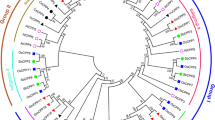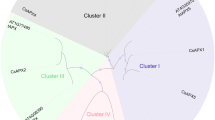Abstract
Here, we report for the first time the genome-wide identification and expression analysis of the molecular chaperone BiP genes in Citrus. Six genes encoding the conserved protein domain family GPR78/BiP/KAR2 were identified in the genome of Citrus sinensis and C. clementina. Two of them, named here as CsBiP1 and CsBiP2, were classified as true BiPs based on their deduced amino acid sequences. Alignment of the deduced amino acid sequences of CsBiP1 and CsBiP2 with BiP homologs from soybean and Arabidopsis showed that they contain all the conserved functional motifs of BiPs. Analysis of the promoter region of CsBiPs revealed the existence of cis-acting regulatory sequences involved in abiotic, heat-shock, and endoplasmic reticulum (ER) stress responses. Publicly available RNA-seq data indicated that CsBiP1 is abundantly expressed in leaf, flower, fruit, and callus, whereas CsBiP2 expression is rarely detected in any tissues under normal conditions. Comparative quantitative real-time PCR (qPCR) analysis of expression of these genes between C. sinensis grafted on the drought-tolerant “Rangpur” lime (C. limonia) and -sensitive “Flying Dragon” trifoliate orange (Poncirus trifoliata) rootstocks showed that CsBiP1 was upregulated by drought stress on the former but downregulated on the latter, whereas the CsBiP2 mRNA levels were downregulated on drought-stressed “Flying Dragon,” but remained constant on “Rangpur.” CsBiP2 upregulation was only observed in C. sinensis seedlings subjected to osmotic and cold treatments. Taken together, these results indicate the existence of two highly conserved BiP genes in Citrus that are differentially regulated in the different tissues and in response to abiotic stresses.




Similar content being viewed by others
References
Alvim FC, Carolino SMB, Cascardo JCM, Nunes CC, Martinez CA, Otoni WC, Fontes EPB (2001) Enhanced accumulation of BiP in transgenic plants confers tolerance to water stress. Plant Physiol 126:1042–1054. https://doi.org/10.1104/pp.126.3.1042
Anderson JV, Li Q, Haskell DW, Guy CL (1994) Structural organization of the spinach endoplasmic reticulum-luminal 70-kilodalton heat-shock cognate gene and expression of 70-kilodalton heat-shock genes during cold acclimation. Plant Physiol 104:1359–1370. https://doi.org/10.1104/pp.104.4.1359
Boston RS, Viitanen PV, Vierling E (1996) Molecular chaperones and protein folding in plants. Plant Mol Biol 32:191–222. https://doi.org/10.1007/978-94-009-0353-1_9
Buzeli RAA, Cascardo JCM, Rodrigues LAZ, Andrade MO, Almeida RS, Loureiro ME, Otoni WC, Fontes EPB (2002) Tissue-specific regulation of BiP genes: a cis-acting regulatory domain is required for BiP promoter activity in plant meristems. Plant Mol Biol 50:757–771. https://doi.org/10.1023/A:1019994721545
Cascardo JCM, Almeida RS, Buzeli RAA, Carolino SMB, Otoni WC, Fontes EPB (2000) The phosphorylation state and expression of soybean BiP isoforms are differentially regulated following abiotic stresses. J Biol Chem 275:14494–14500. https://doi.org/10.1074/jbc.275.19.14494
Cascardo JCM, Buzeli RAA, Almeida RS, Otoni WC, Fontes EPB (2001) Differential expression of the soybean BiP gene family. Plant Sci 160:273–281. https://doi.org/10.1016/S0168-9452(00)00384-8
Denecke J, Goldman MH, Demolder J, Seurinck J, Botterman J (1991) The tobacco luminal binding protein is encoded by a multigene family. Plant Cell 3:1025–1035. https://doi.org/10.1105/tpc.3.9.1025
Figueiredo JEF, Cascardo JCM, Carolino SMB, Alvim F, Fontes EPB (1997) Water-stress regulation and molecular analysis of the soybean BiP gene family. Rev Bras Fisiol Veg 9:103–110
Fontes EB, Shank BB, Wrobel RL, Moose SP, OBrian GR, Wurtzel ET, Boston RS (1991) Characterization of an immunoglobulin binding protein homolog in the maize floury-2 endosperm mutant. Plant Cell 3:483–496. https://doi.org/10.1105/tpc.3.5.483
Forward BS, Misra S (2000) Characterization and expression of the Douglas-fir luminal binding protein (PmBip). Planta 212:41–51. https://doi.org/10.1007/s0042500003
Gonçalves LP, Alves TF, Martins CP, Sousa AO, Santos IC, Pirovani CP, Almeida A-AF, Coelho Filho MA, Gesteira AS, Soares Filho WS, Girardi EA, Costa MGC (2016) Rootstock-induced physiological and biochemical mechanisms of drought tolerance in sweet orange. Acta Physiol Plant 38:174. https://doi.org/10.1007/s11738-016-2198-3
Gong XQ, Liu JH (2013) Genetic transformation and genes for resistance to abiotic and biotic stresses in Citrus and its related genera. Plant Cell Tissue Organ Cult 113:137–147. https://doi.org/10.1007/s11240-012-0267-x
Guo M, Liu JH, Ma X, Zhai YF, Gong ZH, Lu MH (2016) Genome-wide analysis of the Hsp70 family genes in pepper (Capsicum annuum L.) and functional identification of CaHsp70-2 involvement in heat stress. Plant Sci 252:246–256. https://doi.org/10.1016/j.plantsci
Guy C, Haskell D, Li Q (1998) Association of the proteins with stress the 70 molecular chaperones at low temperature: evidence for the existence of cold labile proteins in spinach. Cryobiology 36:301–314. https://doi.org/10.1006/cryo.1998.2089
Kokame K, Kato H, Miyata T (2001) Identification of ERSE-II, a new cis-acting element responsible for the ATF6-dependent mammalian unfolded protein response. J Biol Chem 276:9199–9205. https://doi.org/10.1074/jbc.M010486200
Korennykh A, Walter P (2012) Structural basis of the unfolded protein response. Annu Rev Cell Dev Biol 28:251–277. https://doi.org/10.1146/annurev-cellbio-101011-155826
Kumar S, Stecher G, Tamura K (2016) MEGA7: molecular evolutionary genetics analysis version 7.0 for bigger datasets. Mol Biol Evol 33:1870–1874. https://doi.org/10.1093/molbev/msw054
Li Y, Humbert S, Howell SH (2012) ZmbZIP60 mRNA is spliced in maize in response to ER stress. BMC Res Notes 5:144. https://doi.org/10.1186/1756-0500-5-144
Liberek K, Marszalek J, Ang D, Georgopoulos C, Zylicz M (1991) Escherichia coli DnaJ and GrpE heat shock proteins jointly stimulate ATPase activity of DnaK. Proc Natl Acad Sci U S A 88:2874–2878. https://doi.org/10.1073/pnas.88.7.2874
Lin JH, Li H, Yasumura D, Cohen HR, Zhang C, Panning B, Shokat KM, LaVail MM, Walter P (2007) IRE1 signaling affects cell fate during the unfolded protein response. Science 318:944–949. https://doi.org/10.1126/science.1146361
Liu JX, Howell SH (2010) bZIP28 and NF-Y transcription factors are activated by ER stress and assemble into a transcriptional complex to regulate stress response genes in Arabidopsis. Plant Cell 22:782–796. https://doi.org/10.1105/tpc.109.072173
Liu JX, Srivastava R, Che P, Howell SH (2007) An endoplasmic reticulum stress response in Arabidopsis is mediated by proteolytic processing and nuclear relocation of a membrane-associated transcription factor, bZIP28. Plant Cell 19:4111–4119. https://doi.org/10.1105/tpc.106.050021
Livak KJ, Schmittgen TD (2001) Analysis of relative gene expression data using real time quantitative PCR and the 2−∆∆CT method. Methods 25:402–408. https://doi.org/10.1006/meth.2001.1262
Mafra V, Kubo KS, Alves-Ferreira M, Ribeiro-Alves M, Stuart RM, Boava LP, Rodrigues CM, Machado MA (2012) Reference genes for accurate transcript normalization in citrus genotypes under different experimental conditions. PLoS One 7:e31263. https://doi.org/10.1371/journal.pone.0031263
Muench DG, Wu Y, Zhang Y, Li X, Boston RS, Okita TW (1997) Molecular cloning, expression and subcellular localization of a BiP homolog from rice endosperm tissue. Plant Cell Physiol 38:404–412. https://doi.org/10.1093/oxfordjournals.pcp.a029183
Naved AF, Ozawa M, Yu S, Miyauchi T, Muramatsu H, Muramatsu T (1995) CBP-140, a novel endoplasmic reticulum resident Ca(2+)-binding protein with a carboxy-terminal NDEL sequence showed partial homology with 70-kDa heat shock protein (hsp70). Cell Struct Funct 20:133–141. https://doi.org/10.1247/csf.20.133
Noh S-J, Kwon C-S, Oh D-H, Moon JS, Chung W-I (2003) Expression of an evolutionarily distinct novel BiP gene during the unfolded protein response in Arabidopsis thaliana. Gene 311:81–91. https://doi.org/10.1016/S0378-1119(03)00559-6
Oh DH, Kwon CS, Hiroshi S, Chung WI, Koizumi N (2003) Conservation between animals and plants of the cis-acting element involved in the unfolded protein response. Biochem Biophys Res Commun 301:225–230. https://doi.org/10.1016/S0006-291X(02)03019-X
Patil CK, Li H, Walter P (2004) Gcn4p and novel upstream activating sequences regulate targets of the unfolded protein response. PLoS Biol 2:e246. https://doi.org/10.1371/journal.pbio.0020246
Reis PAA, Rosado GL, Silva LAC, Oliveira LC, Oliveira LB, Costa MDL, Alvim FC, Fontes EPB (2011) The binding protein BiP attenuates stress induced cell death in soybean via modulation of the N-rich protein mediated signaling pathway. Plant Physiol 157:1853–1865. https://doi.org/10.1104/pp.111.179697
Saitou N, Nei M (1987) The neighbor-joining method: a new method for reconstructing phylogenetic trees. Mol Biol Evol 4:406–425. https://doi.org/10.1093/oxfordjournals.molbev.a040454
Sarkar NK, Kundnani P, Grover A (2013) Functional analysis of Hsp70 superfamily proteins of rice (Oryza sativa). Cell Stress Chaperones 18:427–437. https://doi.org/10.1007/s12192-012-0395-6
Srivastava R, Deng Y, Shah S, Rao AG, Howell SH (2013) BINDING PROTEIN is a master regulator of the endoplasmic reticulum stress sensor/transducer bZIP28 in Arabidopsis. Plant Cell 25:1416–1429. https://doi.org/10.1105/tpc.113.110684
Sung D-Y, Vierling E, Guy CL (2001) Comprehensive expression profile analysis of the Arabidopsis Hsp70 gene family. Plant Physiol 126:789–800. https://doi.org/10.1104/pp.126.2.789
Tajima H, Iwata Y, Iwano M, Takayama S, Koizumi N (2008) Identification of an Arabidopsis transmembrane bZIP transcription factor involved in the endoplasmic reticulum stress response. Biochem Biophys Res Commun 374:242–247. https://doi.org/10.1016/j.bbrc.2008.07.021
Thompson JD, Higgins DG, Gibson TJ (1994) CLUSTAL W: improving the sensitivity of progressive multiple sequence alignment through sequence weighting, position-specific gap penalties and weight matrix choice. Nucleic Acids Res 22:4673–4680. https://doi.org/10.1093/nar/22.22.4673
Valente MAS, Faria JAQA, Soares-Ramos JRL, Reis PAB, Pinheiro GL, Piovesan ND, Morais AT, Menezes CC, Cano MAO, Fietto LG, Loureiro ME, Aragão FJL, Fontes EPB (2009) The ER luminal binding protein (BiP) mediates an increase in drought tolerance in soybean and delays drought-induced leaf senescence in soybean and tobacco. J Exp Bot 60:533–546. https://doi.org/10.1093/jxb/ern296
Voeltz GK, Rolls MM, Rapoport TA (2002) Structural organization of the endoplasmic reticulum. EMBO Rep 3:944–950. https://doi.org/10.1093/embo-reports/kvf202
Wakasa Y, Hayashi S, Takaiwa F (2012) Expression of OsBiP4 and OsBiP5 is highly correlated with the endoplasmic reticulum stress response in rice. Planta 236:1519–1527. https://doi.org/10.1007/s00425-012-1714-y
Wan S, Jiang L (2016) Endoplasmic reticulum (ER) stress and the unfolded protein response (UPR) in plants. Protoplasma 253:753–764. https://doi.org/10.1007/s00709-015-0842-1
Wang H, Niu H, Zhai Y, Lu M (2017) Characterization of BiP genes from pepper (Capsicum annuum L.) and the role of CaBiP1 in response to endoplasmic reticulum and multiple abiotic stresses. Front Plant Sci 8:1122. https://doi.org/10.3389/fpls.2017.01122
Woehlbier U, Hetz C (2011) Modulating stress responses by the UPRosome: a matter of life and death. Trends Biochem Sci 36:329–337. https://doi.org/10.1016/j.tibs.2011.03.001
Wu J, Kaufman RJ (2006) From acute ER stress to physiological roles of the unfolded protein response. Cell Death Differ 13:374–384. https://doi.org/10.1038/sj.cdd.4401840
Xu Q, Chen LL, Ruan X, Chen D, Zhu A, Chen C, Bertrand D, Jiao WB, Hao BH, Lyon MP, Chen J, Gao S, Xing F, Lan H, Chang JW, Ge X, Lei Y, Hu Q, Miao Y, Wang L, Xiao S, Biswas MK, Zeng W, Guo F, Cao H, Yang X, Xu XW, Cheng YJ, Xu J, Liu JH, Luo OJ, Tang Z, Guo WW, Kuang H, Zhang HY, Roose ML, Nagarajan N, Deng XX, Ruan Y (2013) The draft genome of sweet orange (Citrus sinensis). Nat Genet 45:59–66. https://doi.org/10.1038/ng.2472
Yamaguchi-Shinozaki K, Shinozaki K (2005) Organization of cis-acting regulatory elements in osmotic and cold-stress-responsive promoters. Trends Plant Sci 10:88–94. https://doi.org/10.1016/j.tplants.2004.12.012
Yu HY, Ziegelhoffer T, Osipiuk J, Ciesielski SJ, Baranowski M, Zhou M, Joachimiak A, Craig EA (2015) Roles of intramolecular and intermolecular interactions in functional regulation of the Hsp70 J-protein co-chaperone Sis1. J Mol Biol 427:1632–1643. https://doi.org/10.1016/j.jmb.2015.02.007
Zhang L, Zhao H-K, Dong Q-L, Zhang Y-Y, Wang YM, Li H-Y, Xing G-J, Li Q-Y, Dong Y-S (2015) Genome-wide analysis and expression profiling under heat and drought treatments of HSP70 gene family in soybean (Glycine max L.). Front Plant Sci 6:773. https://doi.org/10.3389/fpls.2015.00773
Zhu J, Hao P, Chen G, Han C, Li X, Zeller FJ, Hsam SLK, Hu Y, Yan Y (2014) Molecular cloning, phylogenetic analysis, and expression profiling of endoplasmic reticulum molecular chaperone BiP genes from bread wheat (Triticum aestivum L.). BMC Plant Biol 14(260):260. https://doi.org/10.1186/s12870-014-0260-0
Funding
This work was supported by research grants from CNPq (Process # 306667/2014-2), Instituto Nacional de Ciência e Tecnologia (INCT) de Genômica para Melhoramento de Citros (CNPq Process # 465440/2014-2, and FAPESP Process # 2008/2014/50880-0) and Embrapa (Macroprograma 2). L.R.C. is recipient of a CAPES/PNPD postdoctoral fellowship. M.G.C.C. and C.P.P. are CNPq Research Fellows. The funders had no role in study design, data collection and analysis, decision to publish, or preparation of the manuscript.
Author information
Authors and Affiliations
Contributions
R.F.G., L.P.G., J.C.C.M., and G.S.S. conducted the experiments. R.F.G., L.R.C., A.O.S., and A.M.M.B. analyzed the data and drafted the manuscript. F.C.A., M.G.C.C., and C.P.P. supported the project and designed the experiments. M.G.C.C. polished the manuscript. All authors read and approved the manuscript.
Corresponding author
Ethics declarations
Conflict of interest
The authors declare that they have no competing interests.
Additional information
Communicated by C. Chen
Electronic supplementary material
ESM 1
(DOCX 383 kb)
Rights and permissions
About this article
Cite this article
Guimarães, R.F., Camillo, L.R., Sousa, A.O. et al. Genome-wide identification and expression analysis of the molecular chaperone binding protein BiP genes in Citrus. Tree Genetics & Genomes 14, 90 (2018). https://doi.org/10.1007/s11295-018-1306-5
Received:
Revised:
Accepted:
Published:
DOI: https://doi.org/10.1007/s11295-018-1306-5




